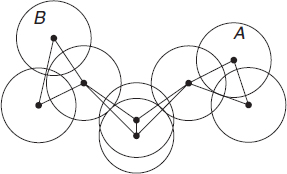1.5 UNIT DISK GRAPH MODELING, HOP COUNT METRIC, AND PROBABILISTIC RECEPTION
Multihop wireless communication in networks of equal devices applying same and fixed transmission radii (i.e., a homogeneous network), has a simple modeling that is an excellent and extremely useful simplification of the complex physical layer. In the unit disk graph (UDG), two nodes communicate if and only if the distance between them is at most R, where R is the transmission radius which is equal for all nodes. A UDG is therefore determined by the positions of nodes and a fixed common transmission range R. To illustrate this, if we use R/2 as the radius of the disk of each node, two nodes are connected if and only if their corresponding disks intersect. An example of a UDG is shown in Figure 1.4 below. Unit disk graphs successfully model WSNs, wireless ad hoc networks (used in rescue, conference, and battlefield scenarios), vehicular network communications, and wireless networks of actuators (to be defined shortly). In combined networks, such as sensor and actuator networks, they can model communication of each component network separately by using different transmission radii for them.

Figure 1.4 An example of a unit disk graph (with radius R/2).
Hop count can be used as a metric for routing in UDG if each node applies the same and fixed transmission power. It is defined as the number of hops from one ...
Get Wireless Sensor and Actuator Networks: Algorithms and Protocols for Scalable Coordination and Data Communication now with the O’Reilly learning platform.
O’Reilly members experience books, live events, courses curated by job role, and more from O’Reilly and nearly 200 top publishers.

